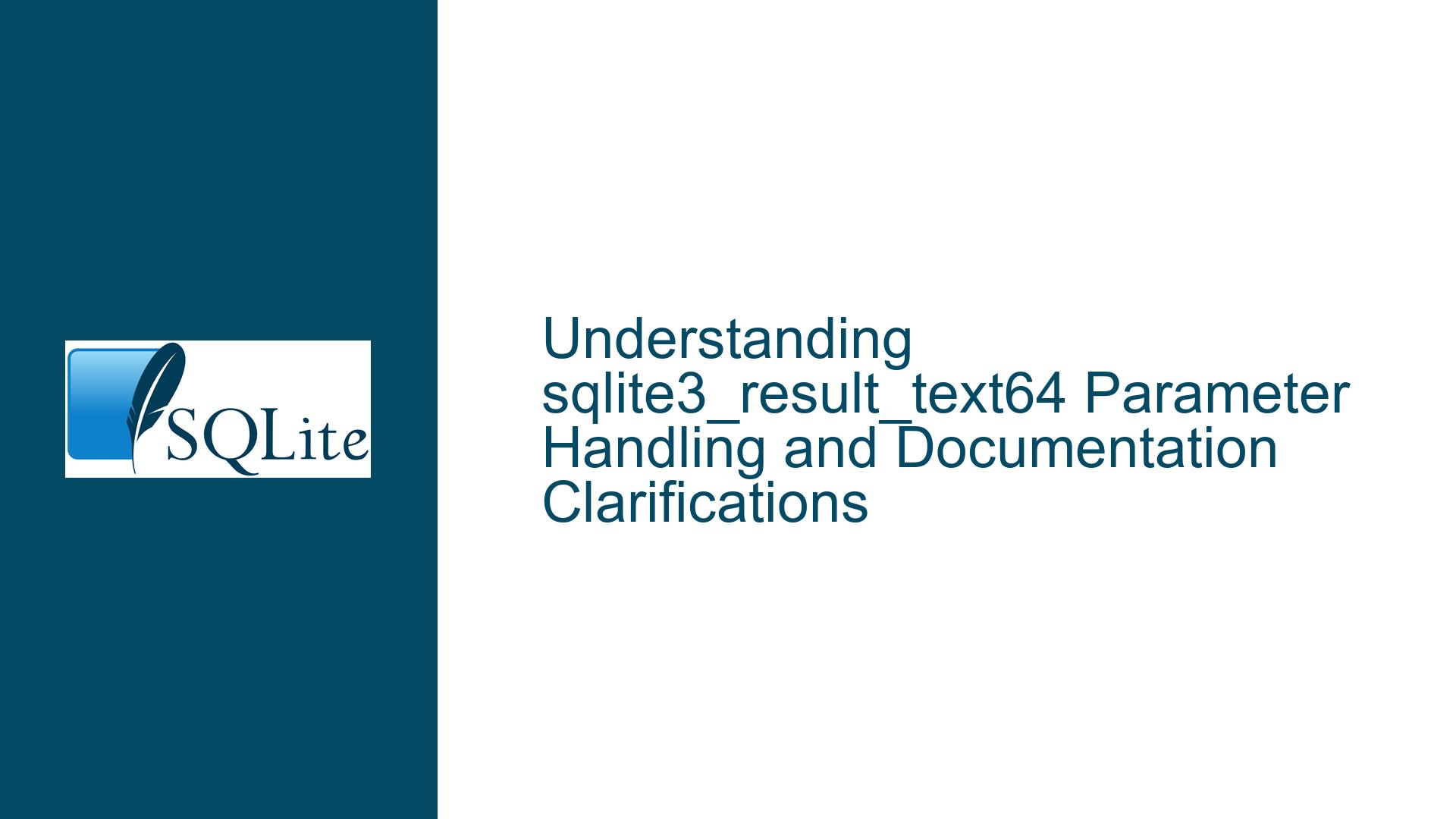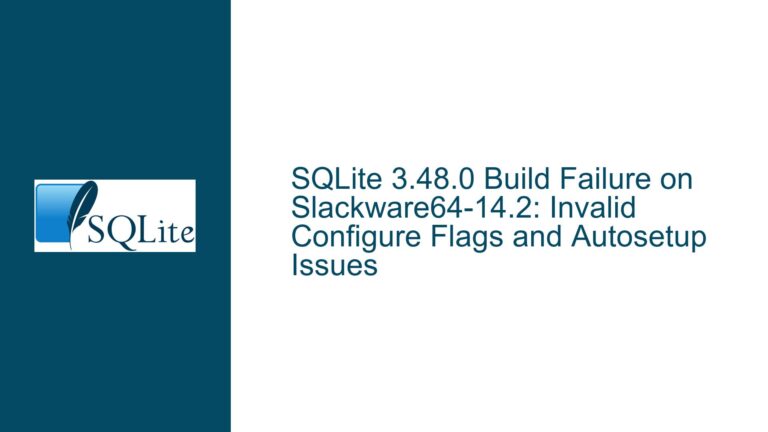sqlite3_result_text64 Parameter Handling and Documentation Clarifications
Issue Overview: sqlite3_result_text64 Third Parameter Behavior and Documentation Discrepancies
The core issue revolves around the use of the third parameter in the sqlite3_result_text64 function, which is declared as a sqlite3_uint64 (an unsigned 64-bit integer). This creates a conflict with the documented behavior inherited from older SQLite text-result functions (e.g., sqlite3_result_text), where a negative value for the third parameter indicates that SQLite should automatically determine the length of the input string by scanning for the first zero-terminator (NUL character). Since sqlite3_uint64 cannot hold negative values, developers face ambiguity in applying the "automatic length detection" feature described in the documentation.
This discrepancy was identified in SQLite’s API documentation, which states that passing a negative value to the third parameter enables automatic length calculation. However, the sqlite3_result_text64 function’s parameter type (sqlite3_uint64) makes this impossible. The confusion arises from whether the parameter type is incorrect (e.g., should it be a signed sqlite3_int64?) or whether the documentation requires clarification.
Further investigation reveals that SQLite internally enforces a maximum allowable size for strings and blobs at 2,147,483,647 bytes (231 – 1). Any attempt to bind or return a value larger than this limit results in an SQLITE_TOOBIG error. When using sqlite3_result_text64, even if a developer attempts to cast -1 to sqlite3_uint64 (resulting in 18446744073709551615), the value exceeds the internal size limit, triggering an error instead of enabling automatic length detection. This behavior diverges from the older sqlite3_result_text function, where -1 is explicitly allowed and handled as a special case.
The problem is compounded by documentation generated directly from SQLite’s source code, which initially did not account for the limitations of the sqlite3_uint64 type in this context. Subsequent corrections to the documentation clarify that automatic length detection is not supported by sqlite3_result_text64 and that developers must explicitly provide the length of the text being returned.
Possible Causes: Unsigned Parameter Type and Internal Size Enforcement
Unsigned Parameter Type Limitation
Thesqlite3_result_text64function uses asqlite3_uint64for its third parameter, which cannot represent negative values. This design choice prevents the use of-1as a sentinel value to trigger automatic length calculation, a feature available in older functions likesqlite3_result_text. Developers accustomed to the older API may incorrectly assume that casting-1tosqlite3_uint64would replicate this behavior. However, the resulting value (18446744073709551615) exceeds SQLite’s internal size limit for strings/blobs, leading to anSQLITE_TOOBIGerror.Documentation Ambiguity
The SQLite documentation initially described the third parameter ofsqlite3_result_text64as behaving identically to its counterparts in older functions, implying that negative values were valid. This was misleading, as the parameter’s unsigned nature and SQLite’s internal size checks make such usage impossible. The documentation has since been revised to clarify that developers must explicitly provide the length when usingsqlite3_result_text64.Internal Size Validation Logic
SQLite enforces a maximum size of 2,147,483,647 bytes for strings and blobs. Whensqlite3_result_text64is called, the third parameter is first validated against this limit. If the value exceeds the limit (including when attempting to cast-1tosqlite3_uint64), the function aborts, raisesSQLITE_TOOBIG, and discards the input string. This validation occurs before any special handling of the parameter, rendering automatic length detection unworkable.Legacy API Compatibility
Thesqlite3_result_text64function was introduced to support 64-bit sizes, but its design inadvertently broke backward compatibility with the negative-length convention. Developers migrating from older functions likesqlite3_result_textmay encounter unexpected errors if they assume equivalent behavior.
Troubleshooting Steps, Solutions & Fixes: Resolving Parameter Handling and Documentation Confusion
Step 1: Verify the Function’s Parameter Requirements
Always provide an explicit length when using sqlite3_result_text64. Unlike older functions, automatic length detection via a negative parameter is unsupported. For example:
// Correct usage with explicit length
sqlite3_result_text64(context, input_text, input_length, SQLITE_TRANSIENT, SQLITE_UTF8);
If the input text is zero-terminated and you wish to avoid manual length calculation, use strlen() (for ASCII/UTF-8) or equivalent functions for other encodings:
sqlite3_result_text64(context, input_text, strlen(input_text), SQLITE_TRANSIENT, SQLITE_UTF8);
Step 2: Handle Large Values Within SQLite’s Size Limits
Ensure the provided length does not exceed 2,147,483,647 bytes. If your input exceeds this limit, truncate it or split it into smaller chunks. For instance:
const char* large_text = ...;
sqlite3_uint64 large_length = ...; // Assume this exceeds 2^31 - 1
if (large_length > 2147483647) {
// Truncate or raise an error
sqlite3_result_error_code(context, SQLITE_TOOBIG);
return;
}
sqlite3_result_text64(context, large_text, large_length, SQLITE_TRANSIENT, SQLITE_UTF8);
Step 3: Migrate Legacy Code Using Negative Lengths
Replace instances where -1 was used to trigger automatic length detection. For example, refactor:
// Legacy code (sqlite3_result_text)
sqlite3_result_text(context, input_text, -1, SQLITE_TRANSIENT);
to:
// Updated code (sqlite3_result_text64)
sqlite3_result_text64(context, input_text, strlen(input_text), SQLITE_TRANSIENT, SQLITE_UTF8);
Step 4: Consult Updated Documentation
Review the latest SQLite documentation for sqlite3_result_text64, which now states:
The third parameter must be a non-negative value indicating the number of bytes in the input text. If the text is zero-terminated, the application must compute its length explicitly.
Avoid relying on historical descriptions of the function’s behavior.
Step 5: Use Alternative Functions for Automatic Length Detection
If automatic length detection is critical, use sqlite3_result_text instead, which accepts a signed int for the length parameter:
sqlite3_result_text(context, input_text, -1, SQLITE_TRANSIENT);
Note that this limits the input size to 231 – 1 bytes.
Step 6: Validate Parameter Casting and Size Checks
If you must cast values to sqlite3_uint64, ensure they do not exceed the maximum allowed size. For example:
int64_t user_length = ...; // Signed value from user input
if (user_length < 0 || user_length > 2147483647) {
// Handle invalid length
} else {
sqlite3_result_text64(context, input_text, (sqlite3_uint64)user_length, SQLITE_TRANSIENT, SQLITE_UTF8);
}
Step 7: Monitor for Future API Updates
The SQLite development team has acknowledged this inconsistency. Future versions may introduce a new function or parameter convention to restore automatic length detection for 64-bit APIs. Subscribe to SQLite’s release notes or changelogs for updates.
Final Solution Summary
The sqlite3_result_text64 function requires developers to explicitly specify the length of the input text. Automatic length detection via a negative parameter is impossible due to the unsigned type and internal size constraints. Update existing code to compute the length manually, truncate oversized inputs, and refer to corrected documentation. For zero-terminated strings, use strlen() or equivalent methods to determine the length before calling sqlite3_result_text64.






